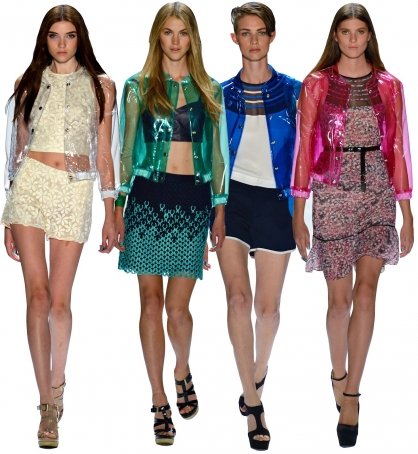Environmental Concern Rises as Use of Plastics in Fashion Grows
Plastic clothes and accessories may look fantastic strutting down the runway, but are not winning fans among the environmentally inclined, reported Australia’s The Age.
Although H&M and Stella McCartney decided to use recycled plastic bottles as material for their latest lines, many other leading brands are not jumping on board with eco-friendly uses of the material.
Plastic appears to be one of the hot trends this season. Charlotte Ronson, Jean Charles de Castelbajac and Givenchy have included the material in their see-through plastic apparel and Margiela and Michael Kors used it for their Perspex shoes. Plastic has also worked its way into the accessories lines of Valentino and Gucci, even appearing on Burberry Prorsum's ''doctor'' bag.
Frequently found in packaging, car parts and building material, polyvinyl chloride, known as vinyl, is the third most widely produced plastic around the globe. PVC is a cheap substitute for rubber and leather, giving a distinctive shine to apparel and accessories. The real attraction of such synthetic materials is the price.
“Buyers are becoming more price conscious and savvy, looking for the runway looks at affordable prices,” Connie Gialouris, the national wholesale manager for Australian label Shakuhachi, said.
According to Greenpeace, PVC is the most harmful to the environment of all plastics. Sophi MacMillan, the chief executive of the Vinyl Council of Australia, however, believes the material has come a long way. Since Greenpeace’s criticism 20 years ago, the plastics industry has greatly improved the manufacturing procedures and life cycle of vinyl.
“PVC's environmental performance is comparable to – or even better than – alternative materials,” she said.
The executive director of environmental group Total Environment Centre, Jeff Angel, thinks the industry should take a good, hard, long look at vinyl’s environmental impact.
“Plastic fashion has to ask itself: Are the raw materials sourced in a sustainable manner and how are the clothes disposed and where: the recycle bin or landfill or dumped? Finally, are there more environmentally responsible alternatives?” Angel said.
Paul Johnston, the principal scientist at Greenpeace Research, maintained that the organization intends to continue its opposition of making apparel with the plastic.
''Use of plastics involves use of oil as a feedstock, which is a non-renewable resource, and some serious questions remain about the impacts of plastics … which would only be added to if they became widely used in clothes,'' Dr. Johnston explained.




